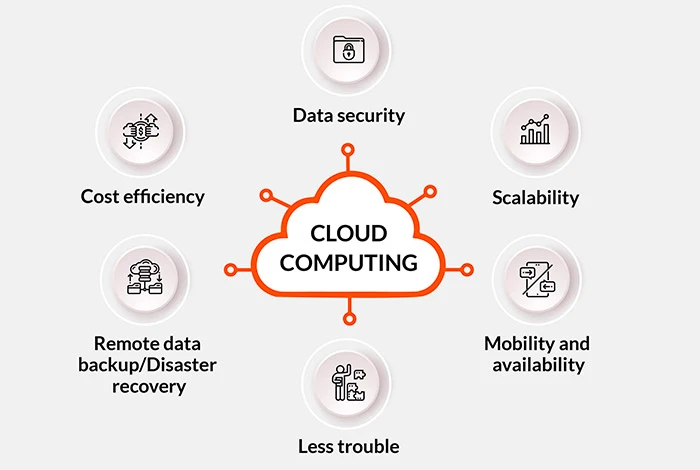Cloud computing might sound like a fancy term, but it is quite simple. In our daily lives, we use a few computing platforms to simply manage and store data.
Businesses are now moving rapidly from traditional methods of data storage to cloud computing. It is more cost-effective in terms of creating a data backup, recovering data, streaming, data analysis, connecting people, etc.
So, here’s a guide for all those who want to have a better understanding of utility cloud, its advantages, and a lot more.
What Is Cloud Computing?
In simple terms, cloud computing means storing, computing, and accessing data over the cloud or internet. It offers services that include storage, networking, analytics, servers, and intelligence over cloud.
It eliminates the need for businesses to invest in buying and maintaining offline data centers. Further, it offers flexible payment options, where you can start with a free plan, and upgrade as you require, or even go for a pay per usage plan.
Why Does Your Business Need Cloud Computing?

Working on physical hard drives and servers comes with its own risks and limitations. But this can help businesses overcome them by ensuring scalability, data backup, easy access, data analysis, reduced cost, and less maintenance.
Knowingly or unknowingly, your business is already using some or the other kind of cloud computing for daily tasks. For example, your business uses email services by Gmail or storage services by Dropbox. Here, you store your data on virtual servers and not on your systems or mobiles.
Let’s understand some other reasons why your business needs cloud computing:
- Storing & Backing Up Data
It is one of the most cost- effective ways for your business to manage your data over the internet or cloud. You can simply transfer your data to cloud storage and access it at any time. It also creates a backup for your data on a secure server.
- Streaming Audio and Video
You can use social media platforms that run on cloud computing to stream audio and video to connect to your audience anytime, anywhere by using any device. These platforms offer global distribution of HD quality audio and video.
- Data Analysis
The power of utility cloud allows its users to gain valuable insights into their consumers’ buying patterns through the data collected by cloud applications. This can help businesses to set their marketing targets and design marketing campaigns through Artificial Intelligence (AI) and Machine Learning (ML).
- Creating Cloud Applications
By using the cloud infrastructure, businesses can reduce the time and cost spent on the development of an application. They can use technologies such as Kubernetes, containers, micro services architecture, and more to develop, deploy, and scale cloud-native applications.
Suggested Read: What is Data Security in Cloud Computing: Best Practices & Challenges?
Types of Cloud Computing
There are many types of cloud computing deployment, as there is not one size that fits all business needs. Let’s understand the different types to select the one that best suits your requirements.
- Public Cloud
The public cloud space is owned, operated, and governed by a third party. In this infrastructure, the complete software and hardware are managed and owned by the cloud provider itself. It is generally used in Business to Consumer (B2C) types of interactions. Microsoft Azure is one good example to understand a public cloud.
- Private Cloud
A private cloud refers to a resource that is dedicated to an individual organization or business. In this infrastructure, cloud servers can be physically deployed at the organization’s on-site data center. However, the company can hire a third-party service provider to manage its private cloud. This type is majorly used in the case of intra-business interactions.
- Hybrid Cloud
The hybrid cloud infrastructure is a combination of both the private cloud and the public cloud. It allows businesses to switch between the two, allowing them to achieve greater flexibility, security, deployment options, and compliance. A hybrid cloud computing is a type of utility cloud that can be used for both types of business interactions, B2C and B2B.
Types of Cloud Computing Services

All the services can be broadly categorized into three categories, SaaS, PaaS, and IaaS. Let’s understand in detail what each of them means in cloud computing.
- SaaS in Cloud Computing
SaaS, also known as Software as a Service, is a distribution model where applications are made available to users via the internet. Compared to the traditional method, where the software is first purchased and then installed on the system, in the SaaS utility cloud service, users can just subscribe to the software. These subscriptions can be taken on a monthly basis or pay-per-usage model as available with the software.
- PaaS in Cloud Computing
PaaS, also known as Platform as a Service, provides developers an environment and platform to build their own applications and services. PaaS offers all the necessary tools required for application development such as networking, storage, collaboration, testing, support, and other management services. Using these, developers can quickly create mobile or web applications without worrying about the infrastructure.
- IaaS in Cloud Computing
IaaS, also known as Infrastructure as a Service, is a service where users can rent an IT infrastructure that includes Virtual Machines (VMs), networks, servers, and operating systems from any third-party cloud provider. It is great for small businesses who are just starting, as IaaS utility cloud service is offered through a pay-as-per-usage payment model.
Suggested Read: Detailed Difference Between PaaS vs. SaaS
Advantages of Cloud Computing
Shifting from traditional storage to cloud computing can offer a lot of advantages to businesses. Some of the benefits include reduced cost, increased productivity, scalability, enhanced performance, and more.
- Cost Effective
One of the biggest advantages is that businesses no longer need to invest in hardware or software. Cloud infrastructure eliminates the need of building and running on-site data centers, setting up racks, having electricity and cooling 24*7, and more.
- Globally Scalable
Another benefit is that it is highly scalable, for both small businesses and large enterprises. You can subscribe or demand IT resources such as storage, bandwidth, and less or more computing power as per your requirement and geographic location.
- Enhanced Performance
Cloud computing service providers regularly update their data centers with the latest technologies to ensure fast and efficient performance. It is much better than a single corporate data center, as it offers reduced network latency and better economies of scale.
- Uptight Security
Cloud service providers strengthen your data security with their latest policies and technologies. They make sure that all of your infrastructure, applications, and data are protected from external threats and attacks.
Suggested Read: What is SaaS in Cloud Computing and How It Works | What is Azure Cloud Computing and Why use it?
Examples of Cloud Computing Across Different Industries

- Healthcare
In healthcare is used in the form of e-health services, telemedicine, bioinformatics, etc. This can be used by doctors and other medical practitioners to host data and analytics, do remote diagnostics, and more. It allows them to have quick access to information, which helps with faster updates and prescriptions.
- Storage Platforms
Cloud storage platforms are the most widely used examples of cloud computing among enterprises. It helps users to create backups, sync files from their system, manage and store data, etc. Gmail and Dropbox are popular names in this industry. Additionally, storing data in real-time also includes social media platforms such as Facebook and Instagram, which also allow instant messaging.
- Government
Government sectors can use it to efficiently deliver their e-Governance services to the citizens. Utility cloud has the capability to host a large infrastructure, multiple huge number of transactions, and a good number of citizens.
- Ed Tech
Modern education setups use e-learning platforms based on cloud computing. E-learning platforms allow students to create presentations, conduct video conferencing classes, and even take exams. It has surpassed the geographical barriers of education and connected educators to students all over the world.
- Big Data Analytics
Allows data scientists to analyze data patterns, correlations, insights, etc., helping them to make predictions and assumptions. Some of the popular big data analytics tools are Hadoop, Cassandra, etc.
Conclusion
Eventually small and large businesses will have to move on to cloud, so it’s better to start preparing from now. Especially when businesses, education, banking, and every other industry is moving towards remote working, moving to cloud becomes critical.
It will help you to stay updated with the latest cloud computing technology, create your own applications, live stream audio & video, conduct data analysis, and create a backup for your complete data in a secure environment.
Related Categories: Cloud Management Service | Cloud Security Services | Cloud Analytics Solutions
Cloud Computing FAQs
Do Cloud Computing Services Have Physical Servers?
Yes, cloud computing services can have physical servers hosted by third party service providers. It majorly works by dividing physical servers into various virtual or cloud servers.
Is Cloud Computing Safe?
Yes, it is safe, when service providers use a well-designed security strategy. It helps in reducing the risk of external attacks on your critical data.
Who uses cloud computing?
Cloud computing is used by individuals as well as businesses in different industries such as healthcare, education, government projects, and more.
What is cloud computing with example?
Cloud computing is storing, computing, and accessing information, over the cloud or internet. Some of the examples that we use in our daily lives are Gmail, Dropbox, OneDrive, etc.
What is the benefit of cloud?
The benefits of cloud computing includes cost effectiveness, scalability, increased productivity, security, and improved performance.
What is IaaS in cloud computing?
IaaS in cloud computing is Infrastructure as a Service, where users can rent an IT infrastructure that includes Virtual Machines (VMs), networks, servers, and operating systems for any third-party cloud provider.
What is PaaS in cloud computing?
PaaS in cloud computing is Platform as a Service where developers are provided an environment and platform where they can build their own applications and services.
What is SaaS n cloud computing?
Software as a Service, where applications are made available to users via the internet.
Isha’s writing journey started way back in 2018 when she graduated in the field of Journalism & Mass Communication. Since then, she has been writing for all digital and print marketing assets including blogs, editorial reviews, landing pages, emailers, and more. She has contributed her writings to genres... Read more






























